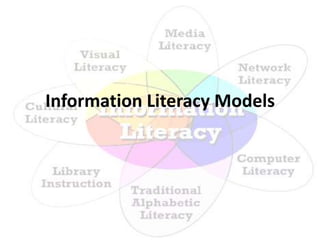
Information literacy model
- 2. What is Information Literacy?
- 3. • Information Literacy is a compelling topic. • Many researchers and education professionals have developed information process models
- 4. • Among these models are the Information Search Process (ISP), FLIP It!, and the BIG6 Process. • The age of the learner is not a factor in the process, but the amount of support needed by a media specialist or educator can be determined by using the guidelines of the models to pinpoint where a learner may be.
- 5. Information Literacy Models Information Search FLIF It! Big6 Skills Process (C. Kuhlthau) A. Yucht Eisenberg & Berkowitz Task Initiation Focus Task Definition Topic Selection Locate Information Seeking Topic Exploration Investigate and Implement Location and Access the Information Focus Formulation Produce Use of information Resource Collection Intelligent Thinking Synthesis Presentation If Then Evaluation Assessment
- 6. The Big6 • The Big6 is a process model for information problem-solving. It integrates information search and use skills along with technology tools in a systematic process to find, use, apply, and evaluate information for specific needs and tasks.
- 7. Michael B. Eisenberg is dean of the Information School of the University of Washington. Mike, and his co-author Bob Berkowitz, created the Big6 approach to information problem-solving, and Mike has worked with thousands of students (preK through higher education), as well as people in public schools, business, government, and communities to improve their information and technology skills.
- 8. Mike has written numerous books and articles on aspects of information science and librarianship, information literacy, library media work, and information technology.
- 9. The Big6
- 10. 1. Task Definition 1.1 Define the information problem 1.2 Identify the information needed (to solve the information problem)
- 11. Task Definition is the stage of the Big6 that gives students the most difficulty. Students should be able to: • understand the nature or type of the assignment • select among options • narrow the scope
- 12. • determine exactly what they are expected to do • envision what the end product will look like • know how they will be graded • estimate how much time and effort will be required
- 13. • consider how much information will be needed • determine the types of information to seek out
- 14. 2. Information Seeking Strategies 2.1 Determine all possible sources (brainstorm) 2.2 Select the best sources
- 15. Information seeking strategies is a mind expanding stage of the information problem-solving process. Determine all possible sources) include: • Generating a list of all potential information sources—print, electronic, and human—for a given information problem.
- 16. • Recognizing the full range of technology sources: online databases, news an discussion groups, as well as the Internet.
- 17. 3. Location and Access 3.1 Locate sources (intellectually and physically) 3.2 Find information within sources
- 18. • Location and Access is getting the needed source in your hands. In this stage, students should be able to: • find the sources they need • use indexes, online card catalogs, and Web searches
- 19. • physically locate and check out needed print sources in a library media center • use the index and table of contents of print sources • scan Web sites or digital sources for needed information
- 20. • save Web sites or articles for more in-depth reading later • locate experts and develop interview questions
- 21. 4. Use of Information 4.1 Engage (e.g., read, hear, view, touch) the information in a source 4.2 Extract relevant information from a source
- 22. • Use of Information is where we get to the heart of the matter; • it requires heavy-duty “critical thinking” as students engage the information in a source and • decide what relevant information to use from each source
- 23. 5. Synthesis 5.1 Organize information from multiple Sources 5.2 Present the information
- 24. • Synthesis is the most visible part of the information problem-solving process. It’s the end result, the outcome, the conclusion.
- 25. 6. Evaluation 6.1 Judge the product (effectiveness) 6.2 Judge the information problem solving process (efficiency)
- 26. • Compare the requirements to the results. • Check the appropriateness and accuracy of the information used. • Judge how well their solution is organized.
- 27. • Rate the quality of their final product or performance compared to their personal potential (i.e., Did I do the best that I could?). • Judge the quality of their product to a predefined standard
- 28. Prepared by: Mary May C. Porto BLIS-III Prof. Sheryl C. Farquerabao INFORMATION LITERACY MODELS LIS 122
